Eu Naval Force
-
- The Changing Face of Piracy Maritime Logistics Professional, Q1 2014 #24
Rich Energy Targets helps to keep Piracy in the Public Spotlight
The release of the Captain Phillips movie starring Tom Hanks in October 2013 and the hijacking of two Americans off the coast of Nigeria have brought more public attention to the oldest of all maritime risks: piracy. While piracy has been a concern in the maritime industry for centuries, a new hotspot has emerged off the coast of West Africa in the Gulf of Guinea. Specifically the industry is concerned about attacks occurring in the territorial waters of Benin, Nigeria, Togo and the Ivory Coast. Over the past years, there have been more widespread and violent accidents in this region of the world. In fact, over the summer of 2013, 22 West African states signed a code of conduct regarding piracy prevention and armed robbery against ships. United States Navy ships accompanying the EU Naval Force off Somalia have created an effective ‘international recommended transit corridor.’ Several West African leaders are calling for a similar floating police force in the Gulf of Guinea, one of the most active oil transport and energy hubs in the world today.
At the same time, shipping companies are continuing to report piracy incidents in the Gulf of Aden and the Strait of Malacca in Southeast Asia. Piracy attacks have dropped significantly off the coast of Somalia due to various factors, including active military action, land-based anti-piracy interventions and the increasing use of armed guards on board of ships. However, Allianz Global Corporate & Specialty (AGCS), a leading marine insurer, maintains that this region is still far from safe from pirate attacks. The industry sometimes likens the issue of piracy to a game of ‘whack-a-mole’.
Once one area quiets down a little, there is another hotspot emerging. So overall, it continues to be of great concern to our clients and with that to us.
Changing business models of pirates
Types of piracy in different regions of the world vary. This is important since the management best practices issued by the International Maritime Organization are still focused on the type of piracy that prevailed off the coast of Somalia. Different types of piracy include:- Opportunistic armed robbery occurs when a vessel is approaching or anchored off ports or when ship-to-ship transfers take place (e.g. oil or gas cargo). Usually pirates are after valuables, IT equipment, personal belongings and the cash often kept by the ship’s captain for conducting normal business in foreign countries.
- Cargo theft, mainly fuel oil theft, occurs when vessels are hijacked for several days and oil is transferred to a smaller vessel. This usually involves a criminal element and some maritime insider knowledge.
- Kidnapping is usually associated with the offshore oil industry and the instability of the Niger Delta. Typically, robbery is the main intent.
The main difference between traditional piracy in Somalia and the new wave of piracy emerging in West Africa is that the latter is usually more aggressive and violent and is aimed at obtaining valuables. The pirates often use poles, grapples and ladders and come with two to three skiffs or speedboats.
Piracy frequency numbers
Piracy is a major concern for the marine insurance industry. For instance, the West African territorial waters are excluded from the Hull War trading area and ship owners need to arrange insurance coverage for sailing into such areas in advance. A recent joint study by the International Criminal Police Organization, United Nations office on Drugs and Crime and the World Bank states that from 2005 to 2012, 179 ships were successfully hijacked off the Horn of Africa, primarily off the coast of Somalia. Another study, called ‘Pirate Trails’, using data and evidence from interviews with former pirates, government officials, bankers and others involved in piracy, explores the finances behind piracy and claims that over $339 million in ransom was paid during that period of time.
So what can shipping companies do to prepare for and mitigate the risk of piracy? Tim Donney, Global Head of Marine Risk Consulting at Allianz Global Corporate & Specialty, has some tips for operators shipping in piracy prone waters:- Avoid using very high frequency (VHF) communication, but use secure satellite telephone or email instead
- Vet all communications with external parties and take care when communicating information on cargo onboard to third parties
- Avoid tendering while not immediately conducting cargo operations
- Change routes up occasionally to avoid predictability when a vessel is in the region frequently and following a regular trade route.
- Piracy risk is the greatest at night (the highest risks are between 2200-0300hrs and weekends, Friday to Sunday are the most common days) and increased vigilance is needed. (Operating only in day light hours is not an option for ships.)
- Prior to transiting the Gulf of Aden, alert the Maritime Security Centre for the Horn of Africa (MSCHOA) and advise of your voyage plans. Travel in assigned Transit Groups and utilize the International Recommended Transit Corridor (IRTC), which will allow optimal coordination of naval warships that are operating in the Gulf of Aden.
- Do not refuel in the piracy hotspot areas. For instance, try to refuel in Cape Town in South Africa instead of in the West African region
- Follow the guidelines contained within IMO’s Best Management Practices IV, such as ‘hardening your vessel’ by installing barbed wire to protect the hull and create an effective Citadel aboard ship.
- For vessels transiting West Africa, follow the Guidelines for the Gulf of Guinea, which have been created by Intertanko, BIMCO, NATO and other maritime organizations.
The Use of Armed Guards
The use of armed guard is a legal challenge. In contrast to the international waters off Somalia, coastal states in West Africa do not allow foreign armed guards to enter their territorial waters. Instead, the local navy or army must be used, a process bringing with it lots of uncertainty with respect to naval experience, being able to adapt to critical situations, training and reliability of people sent onboard.
Former US Assistant Secretary of State, Andrew Shapiro stated: “The ultimate security measure a commercial ship can adopt is the use of privately contracted armed security teams. The reason for this is simple: to date, no ship with an armed security team onboard has been successfully pirated.” Yet, there have been instances where fishermen were mistaken for pirates and were inadvertently killed, such as the incident off the coast of India in 2012.
Generally, insurers like Allianz do not endorse or condemn the use of armed guards. If clients choose to use them, then insurers recommend using those that form part of the Security Association for the Maritime Industry (SAMI). This organization certifies maritime security providers worldwide and its members comprise more than 180 security providers, consultants, trainers and maritime security, hardware and technology manufacturers worldwide.
The Root Cause is on Land
Allianz Global Corporate & Specialty has already propagated that more nation building is required in Somalia back in 2011. In Somalia as well as West Africa, the root cause for piracy is the poverty on land and the socio-economic realities of some of the affected countries. One of the driving forces behind piracy in Nigerian waters has been the failure to address the rampant black oil market, making theft a lucrative business. Pirates have become more sophisticated converting fishing trawlers into makeshift oil tankers or bringing some of the captured vessels close enough to the shore in order to siphon the oil into barrels to be sold on the black market. The US obtains 15 percent of its oil supply from this region, so the pirates see ample opportunity for profit here.
Tim Donney stresses: “You have to address the causes and not just the symptoms. And while we are mainly dealing with the transport on water, we need to recognize that the long-term solutions lie on land – whether we are talking about Somalia, West Africa or any other piracy prone area of the world.”
Another contributing factor is the lack of a legal definition of Piracy and lack of legal jurisdiction for prosecution of piracy. The pirate ring leader Muse, who was captured by the US Navy in the Captain Phillips movie, was recently convicted in US federal court for Hijacking, Hostage Taking, & Armed Robbery, but not Piracy. This is because there is no legal definition of Piracy. Also, there is the lack of jurisdiction. Initially, pirates were being tried in Kenya, but the Kenyan government has since taken the position that these are Somali citizens, that attacked ships that are under foreign flags in international waters. So, how does Kenya have any jurisdiction or responsibility to prosecute these pirates? It is reported that over 1,500 pirates have been captured and released by naval ships because of the lack of any legal authority or jurisdiction for their detention or prosecution.
In short, Piracy is a highly complex international problem that continues to exist as long as large income inequalities, poverty and political instability continue to exist. Its face might be changing, but we are still talking about the age-old risk.
(As published in the 1Q 2014 edition of Maritime Professional - www.maritimeprofessional.com)
-
 )
March 2024 - Marine Technology Reporter page: 48
)
March 2024 - Marine Technology Reporter page: 48. . . . . . . . . . . . . . . . . . . . . . . . . . . .(858) 565-8500 1 . . . . . .RTsys . . . . . . . . . . . . . . . . . . . . . . . . . . . . . .www.rtsys.eu . . . . . . . . . . . . . . . . . . . . . . . . . . . . . . .+33 (0) 2 97 89 85 80 3 . . . . . .SAAB Sea Eye, Ltd. . . . . . . . . . . . . . . . . .
-
 )
March 2024 - Marine Technology Reporter page: 40
)
March 2024 - Marine Technology Reporter page: 40NEW TECH OCEANOLOGY INTERNATIONAL 2024 All photos courtesy MTR unless otherwise noted NEW TECH, PARTNERSHIPS LAUNCH IN LONDON With Oceanology International now one month in the rear-view mirror, MTR takes a look at some of the interesting technologies launched before, during and after the London event.
-
 )
March 2024 - Marine Technology Reporter page: 23
)
March 2024 - Marine Technology Reporter page: 23elatively inactive since 2014, the Hunga Tonga–Hunga Ha‘apai (HT-HH) submarine volcano began erupting on December 20, 2021, reaching peak intensity on January 15, 2022. This triggered tsunamis throughout the Pa- R ci? c, destroyed lives and infrastructure, and generated the largest explosion recorded
-
 )
March 2024 - Marine Technology Reporter page: 19
)
March 2024 - Marine Technology Reporter page: 19About the Author vey with the pipe tracker is not required, resulting in signi? - Svenn Magen Wigen is a Cathodic Protection and corrosion control cant cost savings, mainly related to vessel charter. expert having worked across The major advantage of using FiGS on any type of subsea engineering, design
-
 )
March 2024 - Marine Technology Reporter page: 18
)
March 2024 - Marine Technology Reporter page: 18TECH FEATURE IMR There are also weaknesses in terms of accuracy because of FiGS Operations and Bene? ts signal noise and the ability to detect small ? eld gradients. In Conventional approaches to evaluating cathodic protection this process there is a risk that possible issues like coating (CP)
-
 )
March 2024 - Marine Technology Reporter page: 16
)
March 2024 - Marine Technology Reporter page: 16TECH FEATURE IMR Image courtesy FORCE Technology OPTIMIZING CATHODIC PROTECTION SURVEY USING NON-CONTACT SENSORS By Svenn Magen Wigen, FORCE Technology he principle behind sacri? cial anodes, which are water structures, reducing the need for frequent repairs and used to safeguard underwater pipelines
-
 )
March 2024 - Marine Technology Reporter page: 11
)
March 2024 - Marine Technology Reporter page: 11assist in identifying mines and act as a neutralization device. About the Author Bottom mines pose even greater chal- David R. Strachan is a defense analyst and founder of lenges. Unlike contact mines, bottom Strikepod Systems, a research and strategic advisory mines utilize a range of sensors to
-
 )
March 2024 - Marine Technology Reporter page: 8
)
March 2024 - Marine Technology Reporter page: 8how a cheap and We do know that numerous drifting contact mines have been S largely unsophisticated underwater weapon can disrupt observed and neutralized in the western Black Sea, and it is an adversary’s operational and strategic plans. When the war believed that these are moored contact mines
-
 )
March 2024 - Marine Technology Reporter page: 6
)
March 2024 - Marine Technology Reporter page: 6MTR Editorial Advisors Gallaudet Hardy The Honorable Tim Gallaudet, Kevin Hardy is President PhD, Rear Admiral, U.S. of Global Ocean Design, Navy (ret) is the CEO of creating components and Ocean STL Consulting and subsystems for unmanned host of The American Blue vehicles, following a career
-
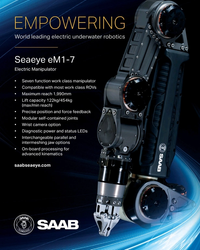 )
March 2024 - Marine Technology Reporter page: 3
)
March 2024 - Marine Technology Reporter page: 3EMPOWERING World leading electric underwater robotics Seaeye eM1-7 Electric Manipulator • Seven function work class manipulator • Compatible with most work class ROVs • Maximum reach 1,990mm • Lift capacity 122kg/454kg (max/min reach) • Precise position and force feedback • Modular self-contained
-
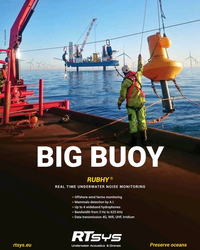 )
March 2024 - Marine Technology Reporter page: 1
)
March 2024 - Marine Technology Reporter page: 1wind farms monitoring > Mammals detection by A.I. > Up to 4 wideband hydrophones > Bandwidth from 3 Hz to 625 kHz > (EXEXVERWQMWWMSR+;M?9,*-VVMHMYQ rtsys.eu Preserve oceans MTR #3 (1-17).indd 1 4/4/2024 8:47:57 A
-
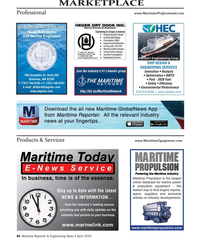 )
April 2024 - Maritime Reporter and Engineering News page: 46
)
April 2024 - Maritime Reporter and Engineering News page: 46MARKETPLACE Professional www.MaritimeProfessional.com GILBERT ASSOCIATES, INC.GILBERT ASSOCIATES, INC. Naval Architects and Marine Engineers SHIP DESIGN & ENGINEERING SERVICES Join the industry’s #1 Linkedin group )NNOVATION
-
 )
April 2024 - Maritime Reporter and Engineering News page: 43
)
April 2024 - Maritime Reporter and Engineering News page: 43ery objective, given the diversity of ship IMO’s review of its formulation of the tems in service.” types, ship ages, routes and services.” CII, or as EU standards evolve to sup- What is also already known is that all port FuelEU maritime requirements to Integrated for Sustainability the solutions proposed
-
 )
April 2024 - Maritime Reporter and Engineering News page: 42
)
April 2024 - Maritime Reporter and Engineering News page: 42are fully aware that rap- tion’s carbon intensity indicator (CII) meeting the shipping industry’s goal for id advances in digital technology are and EU Emissions Trading Scheme are net-zero greenhouse gas emissions by changing the way ships are operated. only early milestones on the regulatory around
-
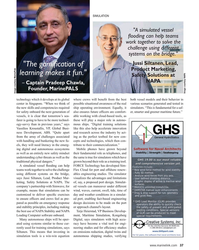 )
April 2024 - Maritime Reporter and Engineering News page: 37
)
April 2024 - Maritime Reporter and Engineering News page: 37and limitations keting, Safety Solutions at NAPA. The of, say, a proposed port design. Simulat- company’s partnership with Simwave, for ed vessels can maneuver under different example, means that simulations can be wind, waves, current, swell, tide, time of customized to deliver speci? c exercises day
-
 )
April 2024 - Maritime Reporter and Engineering News page: 35
)
April 2024 - Maritime Reporter and Engineering News page: 35SIMULATION e have a close relationship with tech- Realism is prized beyond immersive, photo-realistic visu- nology, evidenced by, for example, als, and providers are introducing increasingly accurate func- the phones we are estimated to un- tionality. FORCE Technology’s upcoming DEN-Mark2 math- lock around
-
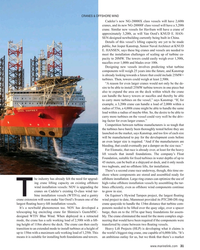 )
April 2024 - Maritime Reporter and Engineering News page: 31
)
April 2024 - Maritime Reporter and Engineering News page: 31CRANES & OFFSHORE WIND Cadeler’s new NG-20000X class vessels will have 2,600t cranes, and its new NG-20000F class vessel will have a 3,200t crane. Similar new vessels for Havfram will have a crane of approximately 3,200t, as will Van Oord’s KNUD E. HAN- SEN-designed newbuilding currently being built in
-
 )
April 2024 - Maritime Reporter and Engineering News page: 29
)
April 2024 - Maritime Reporter and Engineering News page: 29, Used and Rental Options Available AUTHORIZED YOKOHAMA • New Harness Installation 0r Harness Repair with Quick Turnaround FENDER DISTRIBUTOR • Foam and Pneumatic Fenders Available NEW & USED LARGEST INVENTORY IN THE USA IN STOCK & READY TO SHIP • Anchors • b?m]v • Hardware • ou7-]; • Dock • Buoys WORLDWIDE •
-
 )
April 2024 - Maritime Reporter and Engineering News page: 28
)
April 2024 - Maritime Reporter and Engineering News page: 28ten container and roll on/roll off ships, two expeditionary transfer docks (ESDs) and four expeditionary sea base ships. We also have two offshore petro- leum distribution system ships that help move fuel ashore. Another ten preposition ships support the Army and Air Force. It should be pointed out that
-
 )
April 2024 - Maritime Reporter and Engineering News page: 27
)
April 2024 - Maritime Reporter and Engineering News page: 27RADM PHILIP SOBECK, MILITARY SEALIFT COMMAND With COVID, we had to make some hard choices for our Do your CIVMARs have upward mobility? mariners because we couldn’t rotate. Many of our mariners The Navy has Sailors who become “Mustangs,” and work found other employment, and were able to use their skills
-
 )
April 2024 - Maritime Reporter and Engineering News page: 25
)
April 2024 - Maritime Reporter and Engineering News page: 25not without risk. We’ve got to be smart in the disposition of ent, the entire shipping industry is experiencing a shortage. our ships; the way that we maneuver and distribute in a time MSC competes well with the rest of the U.S. maritime indus- of our choosing; all so that we can back up, retrograde, and
-
 )
April 2024 - Maritime Reporter and Engineering News page: 18
)
April 2024 - Maritime Reporter and Engineering News page: 18reduce, driving demand for ad- Given that SOVs and CSOVs operate in a segment target- ditional CSOVs. ing reduced emissions, and many operate in the North Eu- Outside of China, the Asia Paci? c region is in the early ropean segment, characterized by a general strengthening of stages of wind farm development
-
 )
April 2024 - Maritime Reporter and Engineering News page: 14
)
April 2024 - Maritime Reporter and Engineering News page: 14training with respect to be developed shortly by IMO, and/or countries salient design/construction essentials, 6) compliance veri? ca- like Canada and the EU. In the past, only quieting tion methods, and 7) deliverables. Q approaches have been promulgated. As outlined The design process involves associating
-
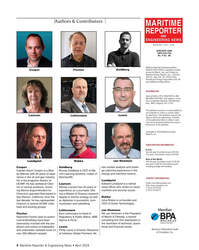 )
April 2024 - Maritime Reporter and Engineering News page: 4
)
April 2024 - Maritime Reporter and Engineering News page: 4Authors & Contributors MARITIME REPORTER AND ENGINEERING NEWS M A R I N E L I N K . C O M ISSN-0025-3448 USPS-016-750 No. 4 Vol. 86 Maritime Reporter/Engineering News (ISSN # 0025-3448) is published monthly Cooper Fischer Goldberg except for March, July, and October by Maritime Activity Reports, Inc.
